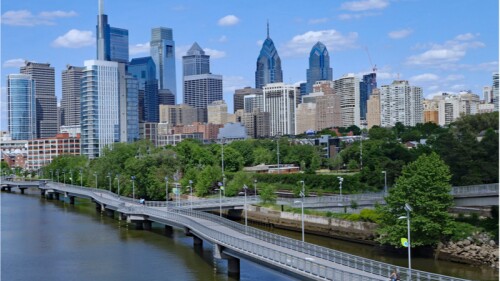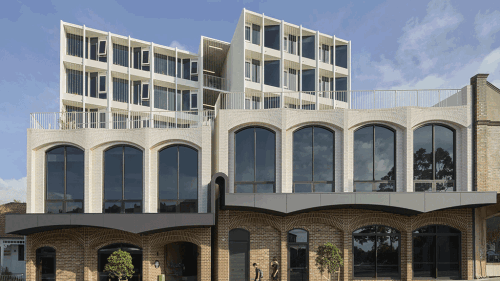For the first time in 30 years, local farmers have returned to the main floor of the historic Oklahoma City Farmers Public Market. Their heirloom tomatoes and organic kale now share the redeveloped 150,000-square-foot (14,000 sq m) landmark with a long list of high-end shops, restaurant and event space, and a “food truck park” next door.
Across the country farmers markets are sharing space with more conventional retail space, often in prominent developments and redevelopments. “We are seeing interest in disparate communities—it certainly is a phenomenon,” says Debra Tropp, supervisory agricultural marketing specialist with the Local Food Research & Development Division for the U.S. Department of Agriculture (USDA).
Not long ago, farmers markets were more likely to be held in church parking lots than in new, Class A developments. Now, top retail developers are making room for farmers markets in their designs, especially in open-air, town center–style projects. They are purposely creating public spaces that can accommodate events like markets to attract more visitors.
“Shopping is part entertainment,” says David Parrish, an architect with RDL Architects. “Programming, like farmers markets, movie nights, musical performances, etc., give that experience to people and make a retail center more like a center of a community.”
New farmers markets are opening in towns across the country. The number of farmers markets listed in the USDA’s farmers market directory—a voluntary listing—has doubled since 2004. The latest directory, published in August, lists 8,476 farmers markets throughout the United States, compared with 3,706 in 2004. More than 85 percent of farmers markets also plan to expand with more vendors, according to a 2014 survey of 1,400 farmers market managers, also by the USDA.
These farmers markets can attract a tremendous amount of people. In Brooklyn, New York, a farmers market held every Saturday draws more than 1,000 visitors an hour to Grand Army Plaza. In Chicago, the oldest farmers market in the city draws huge crowds downtown to Daley Plaza on Thursdays. “From seven in the morning to three in the afternoon, it’s packed,” says Yescenia Mota, who runs the farmers market program for the city of Chicago. “You can’t walk through the [Grand Army] Plaza.”
Retailers Embrace Pop-Up Markets
This kind of retail activity is catnip for retail developers and designers who need to create shopping centers that compete with online retail stores. To win visitors, retailers now provide unique retail experiences that shoppers cannot get through their computers.
“It’s important to be more than just a distribution channel for goods,” says Jesse Tron, spokesperson for the International Council of Shopping Centers (ICSC). “Experience is really top of mind . . . a farmers market is a perfect fit for that.”
That is because farmers markets provide more than just fresh produce, they also allow for interactions that are very different than what a customer experiences at a traditional supermarket or through a website. “You can buy a lot online today, but you cannot eat or carry on an authentic face-to-face relationship on the internet,” says David Kitchens, partner with Cooper Carry Architects. “The farmers market is a key to viable neighborhoods. It is a place where community happens.”
To provide those experiences, new shopping centers often include a variety of public spaces where people can gather. “People want an experience when they go to shop, as opposed to running errands,” says RDL’s Parrish. In open-air, town center–style development, those public spaces can accommodate larger events like farmers markets. “Programming becomes key,” he says. “If done right, the center draws more foot traffic, and can demand higher rents.”
Events like concerts or farmers markets benefit the stores around them with extra traffic. The boost to sales for the stops next door to a farmers market can range from 30 percent to 90 percent of the sales at the farmers market itself, according to a study by Larry Lev and Gary Stephenson at Oregon State University. The bonus is likely to be higher if the farmers market is open at the same time as the retail stores around it, instead of early in the morning before they open, and if the farmers market is in a densely developed location, so that the nearest retail shops are an easy walk from the market.
It helps that a significant portion of the people who shop at farmers markets are the same high-income people many retailers are trying to reach. “Who is the ideal consumer base for heirloom tomatoes?” says ICSC’s Tron. “It’s probably the same person who shops at high-end retail.” Studies have shown that single-person households and affluent couples are the shoppers most willing to pay for “local food” that is grown nearby, says USDA’s Tropp.
The list of stores that tend to locate around prominent, successful farmers markets also reveals a young, affluent consumer. At the Farmers Public Market in Oklahoma City, the list of the retail tenants includes Bikram Yoga OKC, Anthem Brewing, Urban Farmhouse Designs, and many other unique, high-end stores.
As a result, the shops around farmers markets tend to be enthusiastic supporters and often help start the markets. Three-quarters of the 20 farmers markets run by the city of Chicago have close relationships with whatever organization represents the neighborhood business community, usually a chamber of commerce or a special services area program. “They come to us and they are supportive,” Mota says.
At shopping centers, large retailers get farmers markets started, sometimes on a shopping center’s parking lot or on the main street of a newer, open-air retail development. “In many cases, a tenant such as Whole Foods will actually organize and manage the farmers market,” says Ken Smith, a partner with Architects Orange.
It Takes a Village ... to Shop for Dinner
Shoppers are now increasingly likely to assemble their grocery list from several locations: paper towels from Walmart, ground beef from a butcher shop, and produce from a green grocer. Compared with those at traditional supermarkets, sales at fresh-format stores like Whole Foods and limited-assortment stores are growing twice as quickly, according to research from Willard Bishop.
Farmers markets fit smoothly into that larger trend. Visitors to a town center can go from traditional shops to the farmers market and back to the shops as they gather ingredients for the dinner they will have that night.
Ten or 15 years ago, few retail developers would have believed that a grocery store would work in an enclosed mall, as Whole Foods stores do now. “We thought the consumer was very narrow in [his or her] shopping,” says Tron. “They would never mix apparel and grocery shopping into one trip.”
The Great Recession taught retail landlords to break their own rules. “We needed to fill space,” says Tron. As landlords mixed different kinds of retail together to fill shopping centers, they discovered that shoppers were happy to mix different retail experiences. “They like multitasking,” says Tron.
So why doesn’t every mall, especially large-format town centers, have its own farmers market? “The biggest problem would be logistical,” says Tron. A large market requires bringing truckloads of vegetables into the site of the market, often in the center of the development, parking the trucks and setting up the market tents. It is similar to the effort involved in setting up a large concert. Some green markets also provide electricity for vendors who need it. As farmers markets become more popular, more shopping centers are finding ways to make them work.







